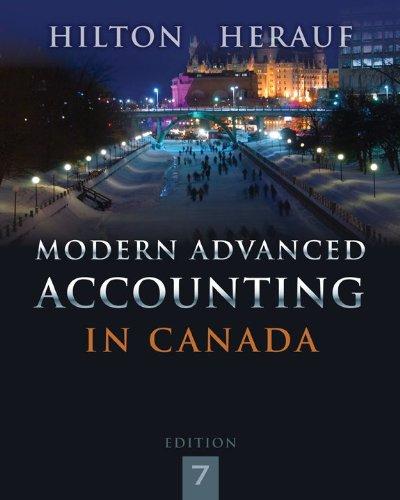The following are the December 31, Year 9, balance sheets of three related companies: Additional Information ¢
Question:
.png)
Additional Information
€¢ On January 1, Year 5, Pro purchased 40% of Forma for $116,000. On that date,
Forma€™s shareholders€™ equity was as follows:
Common shares......... $100,000
Retained earnings........ 80,000
................ $180,000
All of the identifiable net assets of Forma had fair values equal to carrying amounts except for the following, for which fair values exceeded carrying amounts as follows:
Inventory.............. $20,000
Plant and equipment........ 50,000
€¢ One of Forma€™s products, the Epod, was unique in the market place and was a hot seller. Forma could not produce this product fast enough to meet the customer demand. The order backlog would take more than 6 months to complete. An independent appraiser valued the order backlog at $40,000 at the date of acquisition.
€¢ On September 30, Year 7, Pro purchased the remaining 60% of Forma for $300,000. On that date, Forma€™s shareholders€™ equity was as follows:
Common shares.............. $100,000
Retained earnings.............. 110,000
...................... $210,000
On this date, the following net assets of Forma were undervalued by the amounts shown:
Inventory.............. $10,000
Land.............. 60,000
Plant and equipment......... 70,000
€¢ For consolidation purposes, any acquisition differential allocated to plant and equipment is amortized over 20 years from each date of acquisition. A good-will impairment loss amounting to $2,025 was recorded in Year 8.
€¢ During Year 8, Forma issued 2,000 cumulative, $12, no-par-value preferred shares. Pro did not acquire any of these shares.
€¢ The inventories of Pro contained intercompany profits from items purchased from Forma in the following amounts:
December 31, Year 8.............. $40,000
December 31, Year 9.............. 45,000
€¢ During Year 9, Pro and two other unrelated companies formed Apex, which is a joint venture. Pro invested $150,000 cash for its 30% interest in Apex.
€¢ The year-end inventories of Apex contained a $12,000 intercompany profit from items purchased from Pro since its formation in Year 9.
€¢ Forma paid dividends in all years prior to Year 9.
€¢ On December 31, Year 9, the accounts receivable of Pro contained the following:
Receivable from Forma.............. $13,000
Receivable from Apex.............. 40,000
€¢ Use income tax allocation at a 40% rate as it applies to unrealized profits only. Ignore deferred income taxes on the acquisition differential.
Required:
(a) Prepare the Year 9 consolidated balance sheet assuming that
(i) Pro is a public company and reports its investment in Apex using the equity method; and
*(ii) Pro is a private company and reports its investment in Apex using proportionate consolidation.
*(b) Calculate the current ratio for each of the balance sheets in Part (a). Which reporting method presents the strongest liquidity position? Briefly explain.
Balance sheet is a statement of the financial position of a business that list all the assets, liabilities, and owner’s equity and shareholder’s equity at a particular point of time. A balance sheet is also called as a “statement of financial...
Step by Step Answer:

Modern Advanced Accounting In Canada
ISBN: 9781259066481
7th Edition
Authors: Hilton Murray, Herauf Darrell





